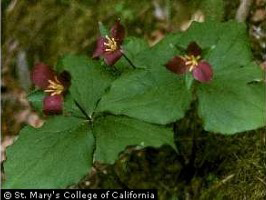This long-lived species grows very slowly and typically takes up to 7 years to flower. It is primarily pollinated by beetles, moths, and bumblebees, and the seeds are dispersed by ants and wasps. This species stores energy in underground rhizomes. The rhizomes were used by Native Americans for medicinal purposes.
Photo Credit: © Brother Alfred Brousseau, 1995 Saint Mary's College of California, USDA-NRCS PLANTS Database.
Trillium ovatum
Common Name: Pacific trillium
Plant Functional Group: Forb
Class > Order > Family: Magnoliopsida > Liliales > Melanthiaceae
What does the species look like?
Pacific trillium is an erect, perennial, herbaceous plant, growing 4 to 18 inches tall. Its showy, white to pink-streaked flowers, often changing to pink with age, have both male and female parts, and occur singly above the bracts/leaves of the plant. Plants begin flowering at about 15 years of age, and are insect-pollinated.
Pacific trillium grows in partially shaded to shaded sites, in moist to wet woods and shaded open sites, along streambanks, and sites that are often bog-like during the spring.
Where is the species found?
States & Provinces
AB, BC, CA, CO, ID, MT, OR, WA, WY
Special Considerations for Observing
If drought seems to be the cause of leaf senescence for a plant, please make a comment about it for that observation.
Which phenophases should I observe?
Do you see...?
Leaves
Initial growth More...
Leaves More...
Flowers
Flowers or flower buds More...
How many flowers and flower buds are present? For species in which individual flowers are clustered in flower heads, spikes or catkins (inflorescences), simply estimate the number of flower heads, spikes or catkins and not the number of individual flowers.
Less than 3 3 to 10 11 to 100 101 to 1,000 More than 1,000
Open flowers More...
What percentage of all fresh flowers (buds plus unopened plus open) on the plant are open? For species in which individual flowers are clustered in flower heads, spikes or catkins (inflorescences), estimate the percentage of all individual flowers that are open.
Less than 5% 5-24% 25-49% 50-74% 75-94% 95% or more
Fruits
Fruits Trillium ovatum , the fruit is a fleshy capsule that changes from green to yellow or yellow-green and drops from the plant.More...
How many fruits are present?
Less than 3 3 to 10 11 to 100 101 to 1,000 More than 1,000
Ripe fruits Trillium ovatum , a fruit is considered ripe when it has turned yellow or yellow-green and readily drops from the plant when touched.More...
What percentage of all fruits (unripe plus ripe) on the plant are ripe?
Less than 5% 5-24% 25-49% 50-74% 75-94% 95% or more
Recent fruit or seed drop More...
How many mature fruits have dropped seeds or have completely dropped or been removed from the plant since your last visit?
Less than 3 3 to 10 11 to 100 101 to 1,000 More than 1,000
What do these phenophases look like?
There is currently no photoguide available for this species. If you'd like help us create one, use the guidance document and species template provided here . Then send it via email to education@usanpn.org when it is complete.
